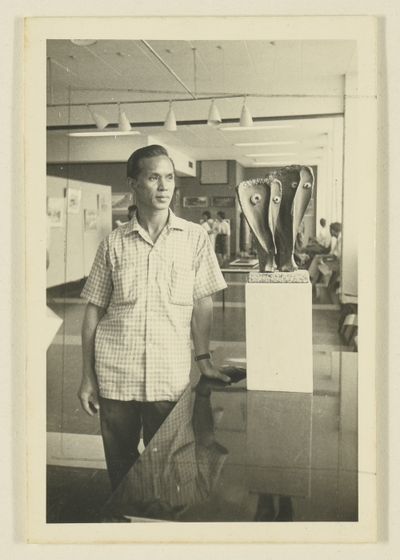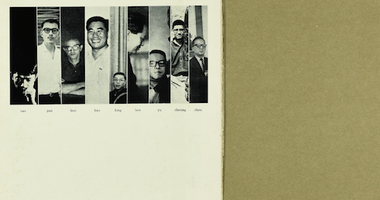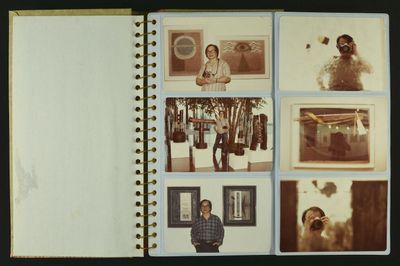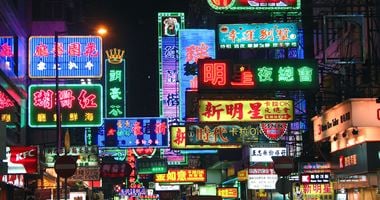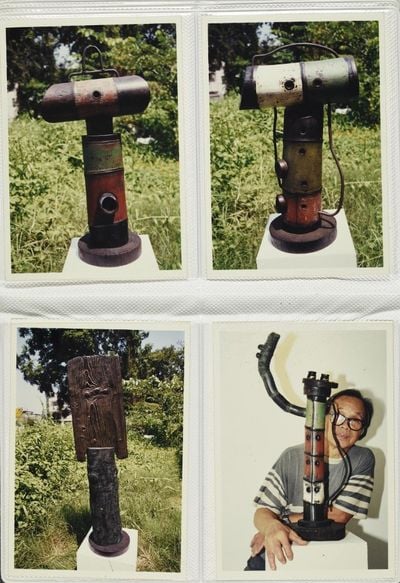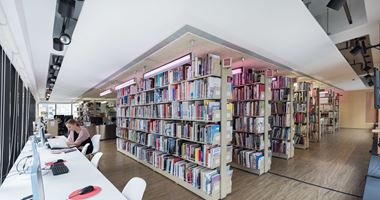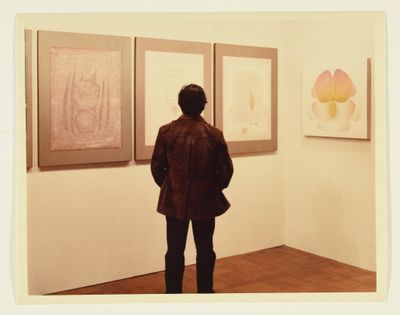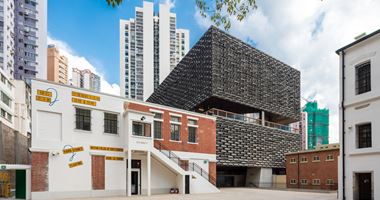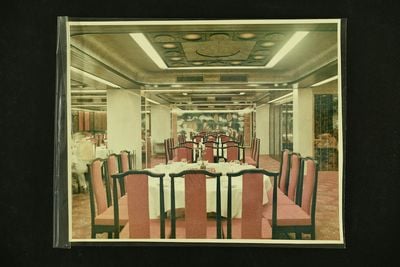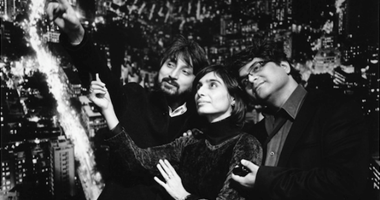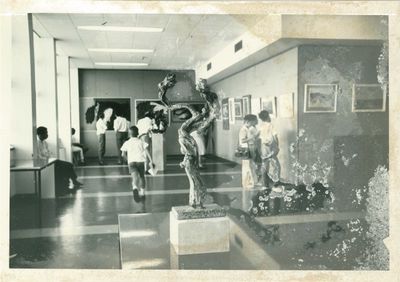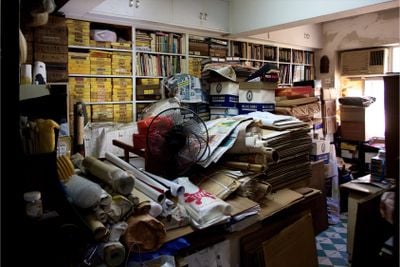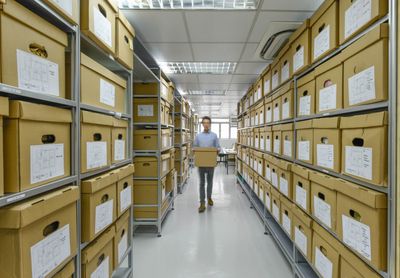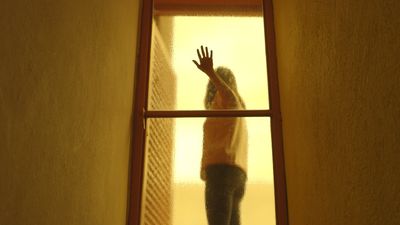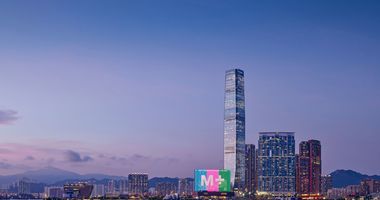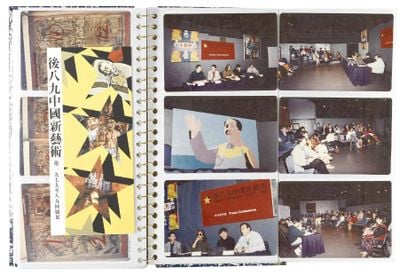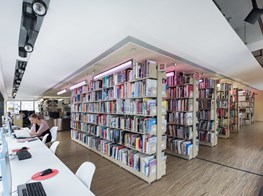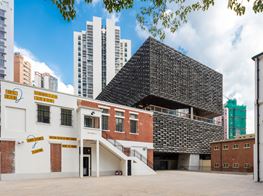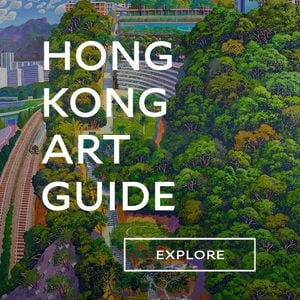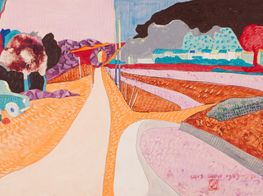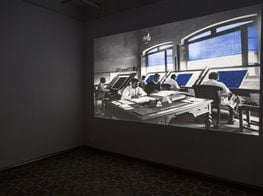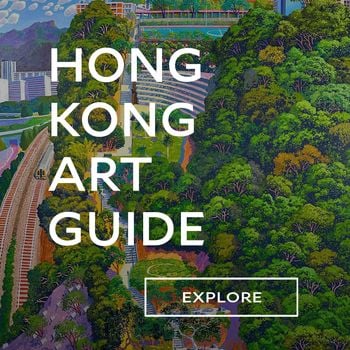Archive Politics in Hong Kong: Activating Ha Bik Chuen's 'Thinking Studio'
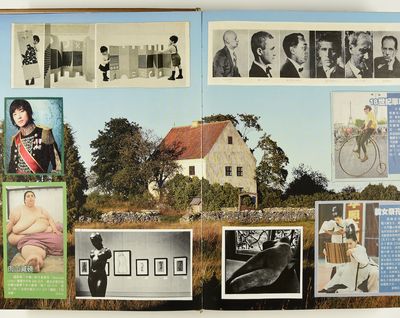
Ha Bik Chuen, page spreads from Country Interiors, large format, hardback book featuring collages of ephemeral materials such as magazine cut-outs and newspaper clippings (2002). Courtesy the Ha Bik Chuen family and Asia Art Archive.
Portals, Stories, and Other Journeys (23 April–1 August 2021), a group show at Tai Kwun's JC Contemporary, engages with Asia Art Archive's (AAA) Ha Bik Chuen Archive Project (2014–2021) to explore the archive as a reflexive space enabling speculative migrations of thought and creative displacements in time.
The 'legend of Ha Bik-Chuen', as the 2011 Hong Kong Museum of Art retrospective, From Common to Uncommon (14 March–17 July 2011) called the artist's biography, has the storyline of the 'Hong Kong dream'. Born in Jiangmen in the west of the Pearl River Delta, Ha went east to the colonies—first Portuguese Macau (1949) then British Hong Kong (1957)—after the Communist Revolution.1
Ha arrived in the city and established Style Handicrafts Factory to industrially produce the handmade paper flowers he sold to churchgoers in Macau. By 1960, he had joined the Chinese Contemporary Artists' Guild led by renowned watercolourist Luis Chan, and, with the rise of the plastic flower industry that made tycoon Li Ka-shing a billionaire, transformed himself from art amateur to professional printmaker as the demand for paper flowers declined.
At this critical juncture, Ha was inspired by the prints of Hong Kong modernist Cheung Yee, co-founder of the Circle Art Group with Van Lau and Hon Chi Fun.2 Unlike Cheung and Van, who received formal art training in Taiwan, Ha and Hon were self-taught.
Whereas Hong Kong-born Hon's studies were interrupted by the Japanese Occupation, Ha stopped schooling in China as early as 1932.3 His learning took place through his work in paint decoration, crafts, and even a short stint in faux antiques.4 Under the influence of Cheung, he developed the practice of accumulating materials from books and magazines.
But as he came to be known for his paper reliefs, bamboo sculptures, and work with found objects, Ha also became Hong Kong's most committed photographer of exhibitions. Artist and educator Kurt Chan Yuk Keung, a student of Cheung's, recalls receiving a photograph of himself at an exhibition in the mail with a note from Ha asking for payment. In both deference and amusement, Chan paid the requested amount.5
In the years since the passing of 'Grandpa Ha' in 2009, AAA—with the support of Ha's wife, Leung Siu Mei—has facilitated his monumentalisation as Hong Kong's unconventional art historian of images via the materials he gathered at his studio on the eighth floor of a Kowloon walk-up.
With funding from the Hong Kong Arts Development Council, The Hong Kong Jockey Club Charities Trust (which also funds JC Contemporary at Tai Kwun), property developer Chinachem Group, and WYNG Foundation, AAA stewarded Ha's materials in conservation, archival systematisation, and digitisation, always maintaining the importance of its artistic activation through artist residencies.
The Ha Bik Chuen Archive comprises materials from what self-taught artist Ha Bik Chuen called his '思考工作室' (Cantonese for 'thinking studio').6 When AAA researcher Michelle Wong, who led the Ha Bik Chuen Archive Project from 2013 to 2020, asked Mrs. Ha if Ha's archiving was part of his artistic practice, she answered with an exclamatory 'Yes!'7
The Tai Kwun exhibition is conceived scenographically in what lead curator Wong calls ten 'sets'.8 Objects like prints, paintings, and sculptures are not included, with the near exception of a paper casting collected as a wall work by the Hong Kong Museum of Art (Construction, 1967), which is mounted on the ceiling as part of Set #2, A Restaurant in 1970s Hong Kong, while a flipbook video in Set #3 features the artist's collage books.
Based on materials from Ha's thinking studio, the work may have been a maquette for a ceiling decoration in a Hong Kong restaurant; a reflection of the archive's potential to change ways of seeing, not just as proof of what has been, but as thresholds onto what is to come.
In addition to the physical and digital materials from the thinking studio, 'sets' also feature new commissions by artists—Kwan Sheung Chi, Lam Wing Sze, Banu Cennetoğlu, Raqs Media Collective, and Walid Raad. Raqs, Raad, and Cennetoğlu were AAA residents in 2009, 2014, and 2019 respectively, and Wong collaborates regularly with Lam in ongoing collective project Sightlines (2016–ongoing).
The curatorial approach at Tai Kwun is a continuation of activation of the archive facilitated by AAA, with materials from Ha's thinking studio activated by invited 'readers'.
For Sailing Through Ha Bik Chuen's Archive (Spring Workshop, 14 October–10 December 2017), for instance, art critic John Batten reconsidered dramatic changes to Hong Kong's Southern District where the initiative Spring Workshop (2011–2018) was located, revisiting the neighbourhood Wong Chuk Hang's once vital printing industry, and studying Sailing in the Sun (1978–1979), Ha's 1978 public sculpture commission nearby in Aberdeen.
During his AAA residency in 2014, Lebanese-American artist Walid Raad saw an affinity between his Beirut-based fictional collaborator Suha Traboulsi and Ha Bik Chuen. Bringing them together, Raad featured Ha as a character in his own ongoing historical fiction about art history in the Arab world.
Raad is credited with discovering Ha's now often displayed found books modified with collaged elements that AAA sees as fundamental to Ha's practice of self-learning.9 Suha Traboulsi created sculptural spaces inspired by Ha's collage books, which included reproductions of Traboulsi's own copies of canonical modern paintings by Middle Eastern artists.
Raad's installation at Tai Kwun—Set #1, Untitled #79—further manipulates scale between miniature replications and reconstructions in real dimensions, exploring the vertigo between watching and being watched in Ha's materials, where Ha is both photographer and subject.10
...Ha's artistic art history of images has been critical to formulating questions about legacy and institutional culture at small but important organisations like AAA in Hong Kong.
Working with materials like leaves, winged seeds, and cut-outs of birds that Ha selected and gathered but did not use in any works, Hong Kong artist and curator Lam Wing Sze's series of animations for Set #4, Thinking Studio, reflexively inhabit Ha's approach, while Raqs Media Collective's Set #6, Unledgered activates the feeling of being in Ha's thinking studio at its original location in To Kwa Wan, jammed with materials like a protective shield against the surrounding landscape in flux.
Chinachem Group, one of the largest property developers in the city since the 1970s, has sponsored the the Ha Bik Chuen Archive Project since 2020, and has been an active emblem of Hong Kong's physical and social transformations over the decades. Ironically, the company is now part of a broader redevelopment scheme in To Kwa Wan that targets old eight-storey tong lau like Ha's with no lifts and unauthorised roof structures.
Turkish artist Banu Cennetoğlu explores the politics of posthumous archives in Set #9, bewitched, bewildered, bothered, a series of interventions she will organise over the course of the exhibition.
Among the screenings and talks that Cennetoğlu has programmed is a showing of American artist Jill Magid's feature film The Proposal (2018), based on Magid's long-term effort to get the archives of Mexican modernist Luis Barragán repatriated to Mexico from Switzerland.
Magid collaborated with Barragán's family to create a diamond from the architect's exhumed cremated ashes. Set in a ring, the diamond was offered as a token for exchange. The art historian who now owns Barragán's archive (which is said to have been an engagement present, hence the ring) has not responded to the gesture.
As Magid has stated about her controversial work, questions around the artist archive—what is accessible and what is not—affect the future that the deceased artist can still participate in creating.11 The question raises difficult questions about the ethics and politics of archives, no less in Hong Kong.
Hong Kong has its own powerful collectors and controversial museum acquisitions. Swiss diplomat and collector, Uli Sigg, donated much of his collection of Chinese art to the M+ Museum of Visual Culture, due to open at the end of this year, leading a recent editorial to call it a 'museum for Swiss collectors' and their ideas of China.
M+ also courted controversy when it purchased the archive of British architecture collective, Archigram, with some arguing the archive was cultural patrimony that should remain in the U.K.
With that in mind, AAA's Ha Bik Chuen Archive Project is crucial not only to the field of Hong Kong studies and Hong Kong art history, but to the broader rethinking of art historiography and the relationship between art history and art practice across geographies.
It is also true, however, that Ha's artistic art history of images has been critical to formulating questions about legacy and institutional culture at small but important organisations like AAA in Hong Kong.
It is fundamental that institutions here actively interrogate their positions in cultural politics at a time when uncompromising stances are staking rigid claims on interpretations of the past that will determine the city's future. —[O]
1 Tang Hoi-chiu, 'Artist's Biography', From Common to Uncommon: The Legend of Ha Bik Chuen, Hong Kong Art Museum (15 April–17 July 2011), exhibition catalogue.
2 Conversation with Kurt Chan, 27 February 2021; and Tang Hoi-chiu, 'Artist's Biography', From Common to Uncommon: The Legend of Ha Bik Chuen, Hong Kong Art Museum (15 April–17 July 2011), exhibition catalogue.
3 Tang Hoi-chiu, 'Artist's Biography', From Common to Uncommon: The Legend of Ha Bik Chuen, Hong Kong Art Museum (15 April–17 July 2011), exhibition catalogue.
4 Conversation with Michelle Wong, 2 March 2020.
5 Conversation with Kurt Chan, 27 February 2021.
6 The phrase '思考工作室' is discussed in Chan Yuk Keung, 'Ha Bik-chuen: a Self-made Artist', Hong Kong Visual Arts Yearbook, (Department of Fine Arts, The Chinese University of Hong Kong: Hong Kong, 2009), p.66–101. Original Chinese and English Translation.
7 Edited by Michelle Wong and Wing Chan, 'Interview with Leung Siu Mei (Mrs Ha)', Ha Bik Chuen Archive, (Asia Art Archive: Hong Kong, 2019): p.155.
8 Conversation with Michelle Wong, 2 March 2020.
9 Edited by Michelle Wong and Wing Chan, Ha Bik Chuen Archive, (Asia Art Archive: Hong Kong, 2019): p.187.
10 Conversation with Michelle Wong, 2 March 2020.
11 Alice Gregory, 'What Happened After Mexico's Greatest Architect was Turned into a Diamond', The New Yorker, 21 May 2017,https://www.newyorker.com/culture/culture-desk/what-happened-after-mexicos-greatest-architect-was-turned-into-a-diamond

